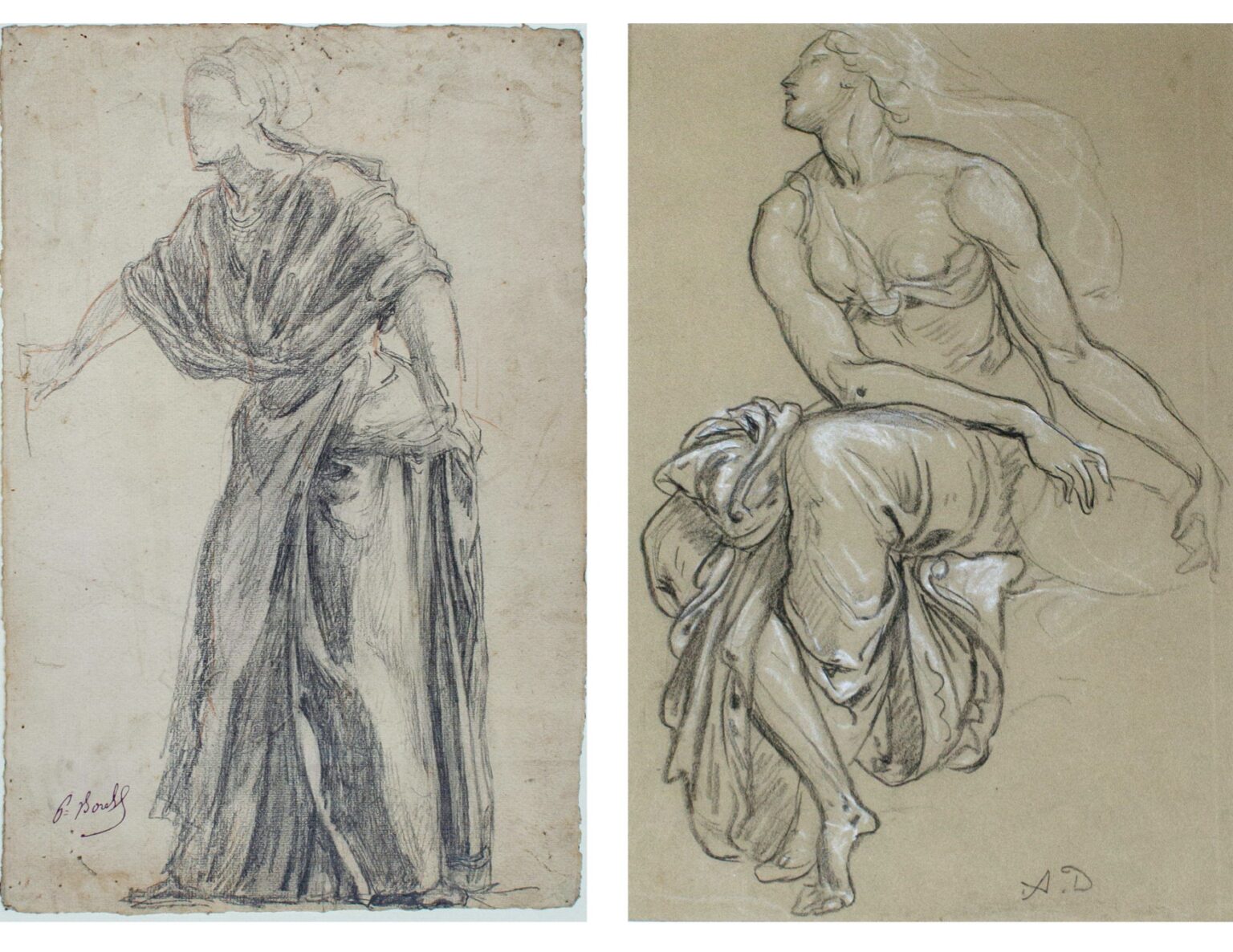
Artist: Paul Borel and Jean Baptiste Arnaud-Durbec
Artist Nationality:
Artist Dates:
Title: 19th Century French Drawings of Draped Women
Date: 19th century
Condition: See description
Medium: See description
Dimensions: See description
Estimated Value: $850
Signature/Markings: See description
Left:
André Marie Paul Borel (French, 1828-1913)
Sketch of a Woman, c. late 19th century
Black and white ink on paper
Sight: 13 ¼ x 8 ½ in.
Framed: 20 ¾ x 14 ¾ x ⅞ in.
Signed lower left
Provenance: Wallector Srl, Rome, IT (2020)
Good condition, some stains and foxing consistent with age
Value: $450
Paul Borel select museum collections: National Gallery of Art, Frances Lehman Loeb Art Center (Vassar College), Cleveland Museum of Art, Musée d'art moderne et contemporain,
Right:
Jean Baptiste François Arnaud-Durbec (French, 1827-1910)
Untitled, 19th century
Drawing mounted to cardboard
Sight: 11 ⅛ x 7 ½ in.
Framed: 16 x 13 ⅝ x 1 in.
Initialed lower right
Provenance: Steffen Völkel Rare Books, Seubersdorf, German
Good condition
Value: $400
Multiple paintings by Arnaud-Durbec can be found in the collection of the Musée Carnavalet, Histoire de Paris.
André Marie Paul Borel Bio:
He was born to a family of merchants. His father died when he was ten, so he and his older brother, Léon, were adopted by his grandmother. Shortly after, he began attending the École Saint-Thomas d'Aquin-Veritas [fr] in Oullins. When Léon became ill, and was sent to the Riviera to recuperate, he began travelling; visiting Saint-Chamond, Ardèche and the Massif du Vercors, where he began making some amateur sketches. Léon died in 1848, prompting him to decide if he wanted to be a priest or an artist.
That same year, he formed a lifelong friendship with the painter, Louis Janmot. The following year, he went to Paris where, with Janmot's assistance, he studied and made copies of the Old Masters at the Louvre. He had his first showing at the Salon de Lyon in 1851, with scenes from the lives of several saints. In 1852, he and Janmot made a grand tour of Italy, seeking inspiration.
In 1855, he spent a year in Paris, studying with Joseph-Victor Ranvier [fr] and Irénée Richard (1821-1906) at the Académie Suisse. He returned to Rome in 1856, where he conducted a lengthy study of the Catacomb of callixtus. That same year, he married Adèle Mouton, the sister of one of his friends at the École Saint-Thomas. In 1857, he had his first showing at the Salon, and took some additional lessons from Hippolyte Flandrin.
After only two years of marriage, Adèle died. To help assuage his grief, he accepted a large commission from the architect, Pierre Bossan, to create murals for the new chapel at the École Saint-Thomas. In 1860, a family inheritance gave him the freedom to work at his own pace. His murals at the École would take him twenty years to complete. After 1863, he focused entirely on religious works and refused to accept any payment. During this time, he made the acquaintance of François-Auguste Ravier, who introduced him to landscape painting techniques.
Between 1880 and 1885, he took a break from his work to travel with his friends, the painter Joseph Trévoux [fr], and the photographer Félix Thiollier; visiting the Massif Central, Belgium, and the Netherlands. His next large projects came in 1898, when he began decorating the chapel of the Augustinians in Versailles, the Église Saint-Paul, and the Église Saint-Joseph [fr] in Brotteaux.
Jean Baptiste François Arnaud-Durbec Bio:
Jean Baptiste François Arnaud-Durbec, known as Arnaud-Durbec, was a French painter from the city of Marseille. Faced with the need to provide for his family, Arnaud-Durbec, the oldest of a numerous family, decides to quit his classical studies and becomes an apprentice in a academy where interior decoration was taught. The skills he learned during his apprenticeship will be highly important in his development as an artist.
He later enrolls in the École des Beaux-Arts in Marseille, first under the direction of the Augustin Aubert (1781-1857), later unter the painter Émile Loubon (1809-1863). Loubon directs him to start working on various side projects votive offerings, decorations for cafés, church paintings, portraits, lithographs. Upon spending some time in Marignane, he gets sick from malaria and is confined to bed, in a serious condition, for three months. After surviving the disease, he returns to Marseille, where he executes paintings for the Church of Estaque. He later paints and decorates parts of the Église Saint Pierre in Avignon, as well.
In 1868, he leaves for Paris, where his career truly takes off. After the Franco-Prussian War in 1870, Arnaud-Durbec meets Félix Philippoteaux (1815-1884), under whose command, together with a group of Parisian artists, he works on the Panorama du siege de Paris" (1870-71). Arnaud-Durbec was also a member the Paris Commune. He is later commissioned to do the decoration of the hunting hall in the Neudeck Castle. Further works on commission follow, as Arnaud-Durbec's reputation grows; he works in various theaters, including Montpellier, and does part of the central dome of the Exposition Universelle of 1881, as well as the hall dedicated to the establishment known as Menus-Plaisirs du Roi. Arnaud-Durbec died in Paris in 1910, ending a long and fruitful career
Provenance:
Both works from a Private New York Collection - for additional provenance see description
Exhibition History:
N/A
Publication History:
N/A